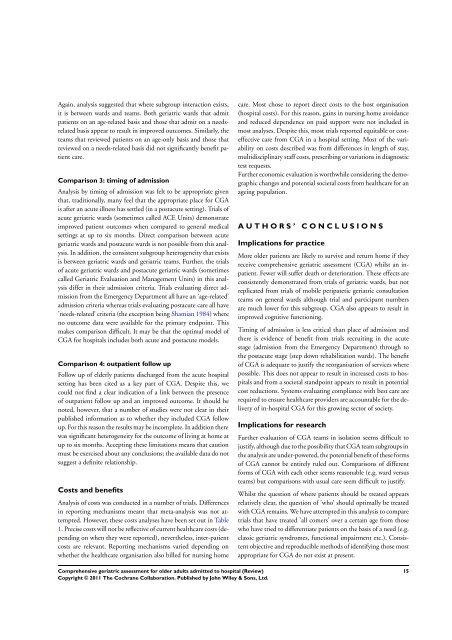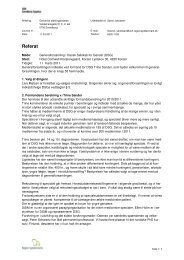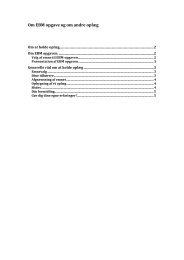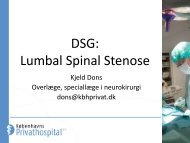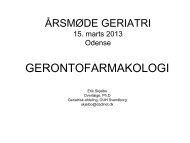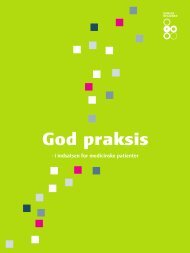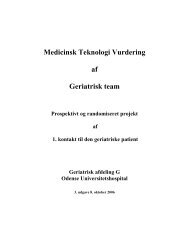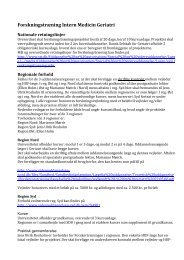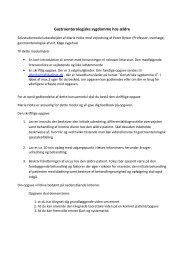Comprehensive geriatric assessment for older adults admitted to ...
Comprehensive geriatric assessment for older adults admitted to ...
Comprehensive geriatric assessment for older adults admitted to ...
Create successful ePaper yourself
Turn your PDF publications into a flip-book with our unique Google optimized e-Paper software.
Again, analysis suggested that where subgroup interaction exists,<br />
it is between wards and teams. Both <strong>geriatric</strong> wards that admit<br />
patients on an age-related basis and those that admit on a needsrelated<br />
basis appear <strong>to</strong> result in improved outcomes. Similarly, the<br />
teams that reviewed patients on an age-only basis and those that<br />
reviewed on a needs-related basis did not significantly benefit patient<br />
care.<br />
Comparison 3: timing of admission<br />
Analysis by timing of admission was felt <strong>to</strong> be appropriate given<br />
that, traditionally, many feel that the appropriate place <strong>for</strong> CGA<br />
is after an acute illness has settled (in a postacute setting). Trials of<br />
acute <strong>geriatric</strong> wards (sometimes called ACE Units) demonstrate<br />
improved patient outcomes when compared <strong>to</strong> general medical<br />
settings at up <strong>to</strong> six months. Direct comparison between acute<br />
<strong>geriatric</strong> wards and postacute wards is not possible from this analysis.<br />
In addition, the consistent subgroup heterogeneity that exists<br />
is between <strong>geriatric</strong> wards and <strong>geriatric</strong> teams. Further, the trials<br />
of acute <strong>geriatric</strong> wards and postacute <strong>geriatric</strong> wards (sometimes<br />
called Geriatric Evaluation and Management Units) in this analysis<br />
differ in their admission criteria. Trials evaluating direct admission<br />
from the Emergency Department all have an ’age-related’<br />
admission criteria whereas trials evaluating postacute care all have<br />
’needs-related’ criteria (the exception being Shamian 1984) where<br />
no outcome data were available <strong>for</strong> the primary endpoint. This<br />
makes comparison difficult. It may be that the optimal model of<br />
CGA <strong>for</strong> hospitals includes both acute and postacute models.<br />
Comparison 4: outpatient follow up<br />
Follow up of elderly patients discharged from the acute hospital<br />
setting has been cited as a key part of CGA. Despite this, we<br />
could not find a clear indication of a link between the presence<br />
of outpatient follow up and an improved outcome. It should be<br />
noted, however, that a number of studies were not clear in their<br />
published in<strong>for</strong>mation as <strong>to</strong> whether they included CGA follow<br />
up. For this reason the results may be incomplete. In addition there<br />
was significant heterogeneity <strong>for</strong> the outcome of living at home at<br />
up <strong>to</strong> six months. Accepting these limitations means that caution<br />
must be exercised about any conclusions; the available data do not<br />
suggest a definite relationship.<br />
Costs and benefits<br />
Analysis of costs was conducted in a number of trials. Differences<br />
in reporting mechanisms meant that meta-analysis was not attempted.<br />
However, these costs analyses have been set out in Table<br />
1. Precise costs will not be reflective of current healthcare costs (depending<br />
on when they were reported), nevertheless, inter-patient<br />
costs are relevant. Reporting mechanisms varied depending on<br />
whether the healthcare organisation also billed <strong>for</strong> nursing home<br />
<strong>Comprehensive</strong> <strong>geriatric</strong> <strong>assessment</strong> <strong>for</strong> <strong>older</strong> <strong>adults</strong> <strong>admitted</strong> <strong>to</strong> hospital (Review)<br />
Copyright © 2011 The Cochrane Collaboration. Published by John Wiley & Sons, Ltd.<br />
care. Most chose <strong>to</strong> report direct costs <strong>to</strong> the host organisation<br />
(hospital costs). For this reason, gains in nursing home avoidance<br />
and reduced dependence on paid support were not included in<br />
most analyses. Despite this, most trials reported equitable or costeffective<br />
care from CGA in a hospital setting. Most of the variability<br />
on costs described was from differences in length of stay,<br />
multidisciplinary staff costs, prescribing or variations in diagnostic<br />
test requests.<br />
Further economic evaluation is worthwhile considering the demographic<br />
changes and potential societal costs from healthcare <strong>for</strong> an<br />
ageing population.<br />
A U T H O R S ’ C O N C L U S I O N S<br />
Implications <strong>for</strong> practice<br />
More <strong>older</strong> patients are likely <strong>to</strong> survive and return home if they<br />
receive comprehensive <strong>geriatric</strong> <strong>assessment</strong> (CGA) whilst an inpatient.<br />
Fewer will suffer death or deterioration. These effects are<br />
consistently demonstrated from trials of <strong>geriatric</strong> wards, but not<br />
replicated from trials of mobile peripatetic <strong>geriatric</strong> consultation<br />
teams on general wards although trial and participant numbers<br />
are much lower <strong>for</strong> this subgroup. CGA also appears <strong>to</strong> result in<br />
improved cognitive functioning.<br />
Timing of admission is less critical than place of admission and<br />
there is evidence of benefit from trials recruiting in the acute<br />
stage (admission from the Emergency Department) through <strong>to</strong><br />
the postacute stage (step down rehabilitation wards). The benefit<br />
of CGA is adequate <strong>to</strong> justify the reorganisation of services where<br />
possible. This does not appear <strong>to</strong> result in increased costs <strong>to</strong> hospitals<br />
and from a societal standpoint appears <strong>to</strong> result in potential<br />
cost reductions. Systems evaluating compliance with best care are<br />
required <strong>to</strong> ensure healthcare providers are accountable <strong>for</strong> the delivery<br />
of in-hospital CGA <strong>for</strong> this growing sec<strong>to</strong>r of society.<br />
Implications <strong>for</strong> research<br />
Further evaluation of CGA teams in isolation seems difficult <strong>to</strong><br />
justify, although due <strong>to</strong> the possibility that CGA team subgroups in<br />
the analysis are under-powered, the potential benefit of these <strong>for</strong>ms<br />
of CGA cannot be entirely ruled out. Comparisons of different<br />
<strong>for</strong>ms of CGA with each other seems reasonable (e.g. ward versus<br />
teams) but comparisons with usual care seem difficult <strong>to</strong> justify.<br />
Whilst the question of where patients should be treated appears<br />
relatively clear, the question of ’who’ should optimally be treated<br />
with CGA remains. We have attempted in this analysis <strong>to</strong> compare<br />
trials that have treated ’all comers’ over a certain age from those<br />
who have tried <strong>to</strong> differentiate patients on the basis of a need (e.g.<br />
classic <strong>geriatric</strong> syndromes, functional impairment etc.). Consistent<br />
objective and reproducible methods of identifying those most<br />
appropriate <strong>for</strong> CGA do not exist at present.<br />
15


